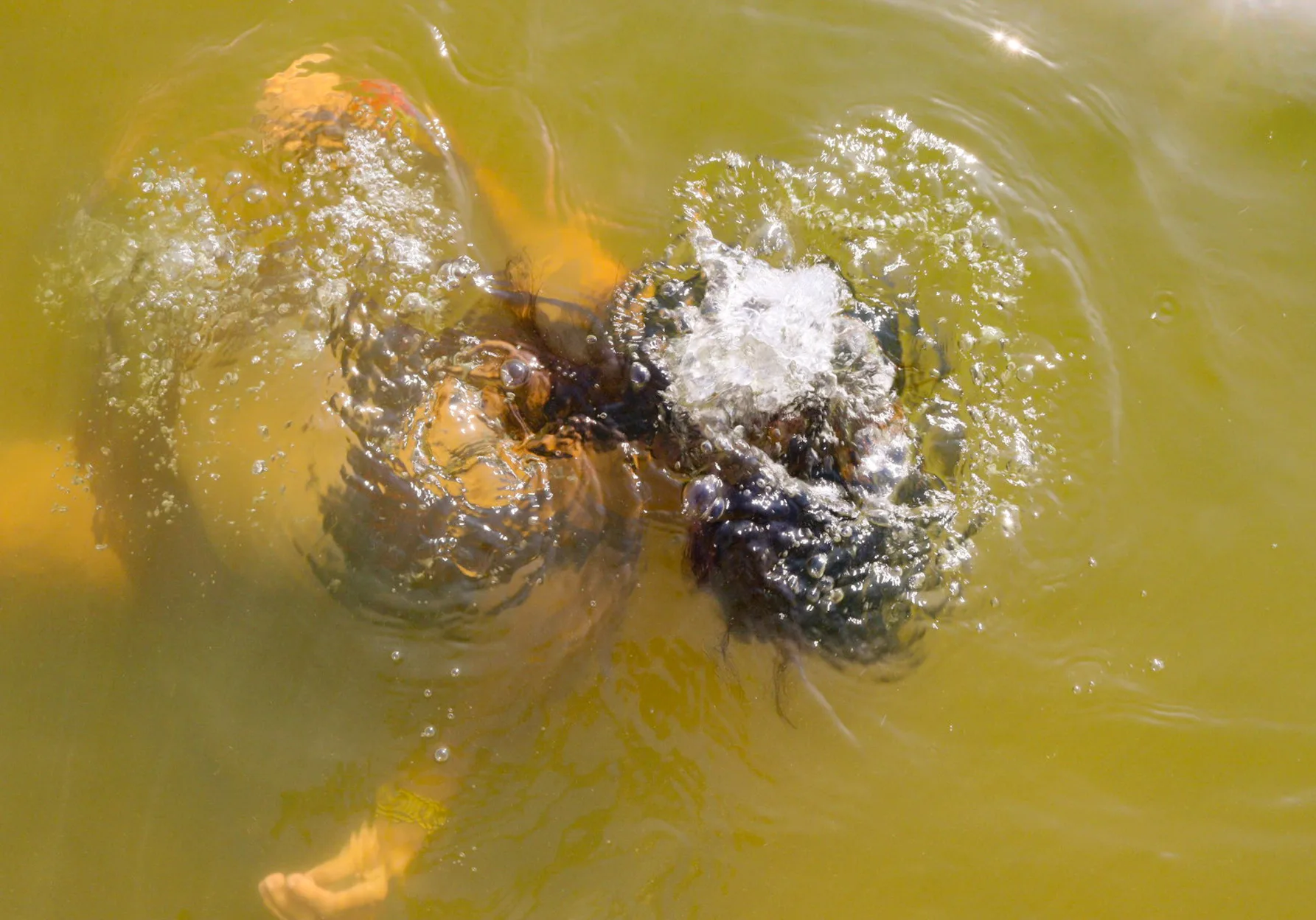“A salvo of fireworks, crabs were jumping next to the stowage to see the saint, and look at the meeting of the Brotherhood, some very rigid old collars and neckties scolding with words from another time, taken from the deceased malocas, from the old chest, from Portuguese arcs, they thus speak sort of gutturally, that Brotherhood’s old cururu-singing morubixaba leaders, more protective of the saint than protected.”
(Translated excerpt from Ribanceira, by Dalcídio Jurandir)
Walking in large strides along the thin road separating Saint Antônio of Gurupá Parish from the steep banks of the Amazon River, a group of revelers dressed in white dress shirts and red capes stands in sharp relief to the landscape. Four are at the front. Two are shouldering flags. They include an elderly man holding a halberd, a type of spear, pointed at the cloudy sky over the city, the colorful ribbons decorating the weapon whipping in the strong wind coming from the river, a sign of rain. Everyone in this group has made a promise to protect the image of a Black saint and the tradition woven into his name over the generations. They are part of the Brotherhood of Revelers of the Glorious Saint Benedito of Gurupá. The only man at the front whose hands are free is Luiz de Jesus Portilho, 70, the Brotherhood’s main leader and the person representing the revelers on the Festival of Saint Benedito board. Among the lower Amazon River’s most beautiful festivals, Gurupá’s streets have been dyed red according to tradition for more than a hundred years.
December is when the revelers usually visit the homes of those who at one time took a vow, asking the saint to help them fulfill their dream of owning a home. They bring sacred musical instruments made of leather and wood. With tambourines, scrapers, percussive truncheons, and milheiros (a type of shaker made from a hollow Pumpwood trunk), they play and sing their songs to a samba beat. Ana Lídia Fernandes Veiga, one of the saint’s devotees and the daughter of Ribeirinhos who are from the region, says her parents took their vow 17 years ago. Once their dream home was built, they were added to the list of those who had received the saint’s grace and, as a result, the revelers’ joy and music. The reward for this visit is a warm welcome and food, “an abundance,” Ana Lídia says. “We anxiously wait for the revelers to arrive.”
This gesture of sharing not only ensures the revelers can remain during the days of the festivities, but it also evokes the nature of Saint Benedict the Moor, as he is known in English, who is known for serving those most in need. The son of slaves, he was born in San Fratello, Italy, in 1526. As a young man in Palermo, Sicily, he joined the Franciscan Order, where he lived a simple life, part of which was spent isolated from the world and dedicated to a spiritual life. “Although he lived alone for years, when he entered the friary he got along well with people, he was a cook, a doorman, a house superior, which is something very significant to history,” says Father Carlos Ébano Costa, who was doing missionary work at the Xingu Diocese, in Altamira. The Black Saint, canonized in 1807 by Pope Pius VII, is beloved all over the world. The patron saint of the Quilombolas, chefs, and the poor, he was also known for his wisdom, despite not knowing how to read or write.
Surrounded by child revelers, near the parish church’s staircase, Francisco de Jesus Portilho, also known as Chico Portilho, is resting between drum beats. He is a guardian of festival knowledge, preserving not only its memory, but conveying it to the young people and children around him. He is a jack of all trades: “I’ll pick up any instrument there is, if there’s no grand master, I get the festivities started; if there’s nobody to play the milheiro, I know how to shake the milheiro, if there’s nobody to beat the truncheons, I do that.” With a tranquility oblivious to the agitation and incessant popping of fireworks all around, he exercises his memory by talking about the ancestors. He recalls a drummer named Zé da Liga, Justino, and another, from the Jocojó Quilombo, named Pedro Lima. He mentions the grand masters who taught him to hype the revelers, his Sponsor Grandfather, Benipombo, Eduardo, Otávio. “They’ve all passed on,” he says in closing.
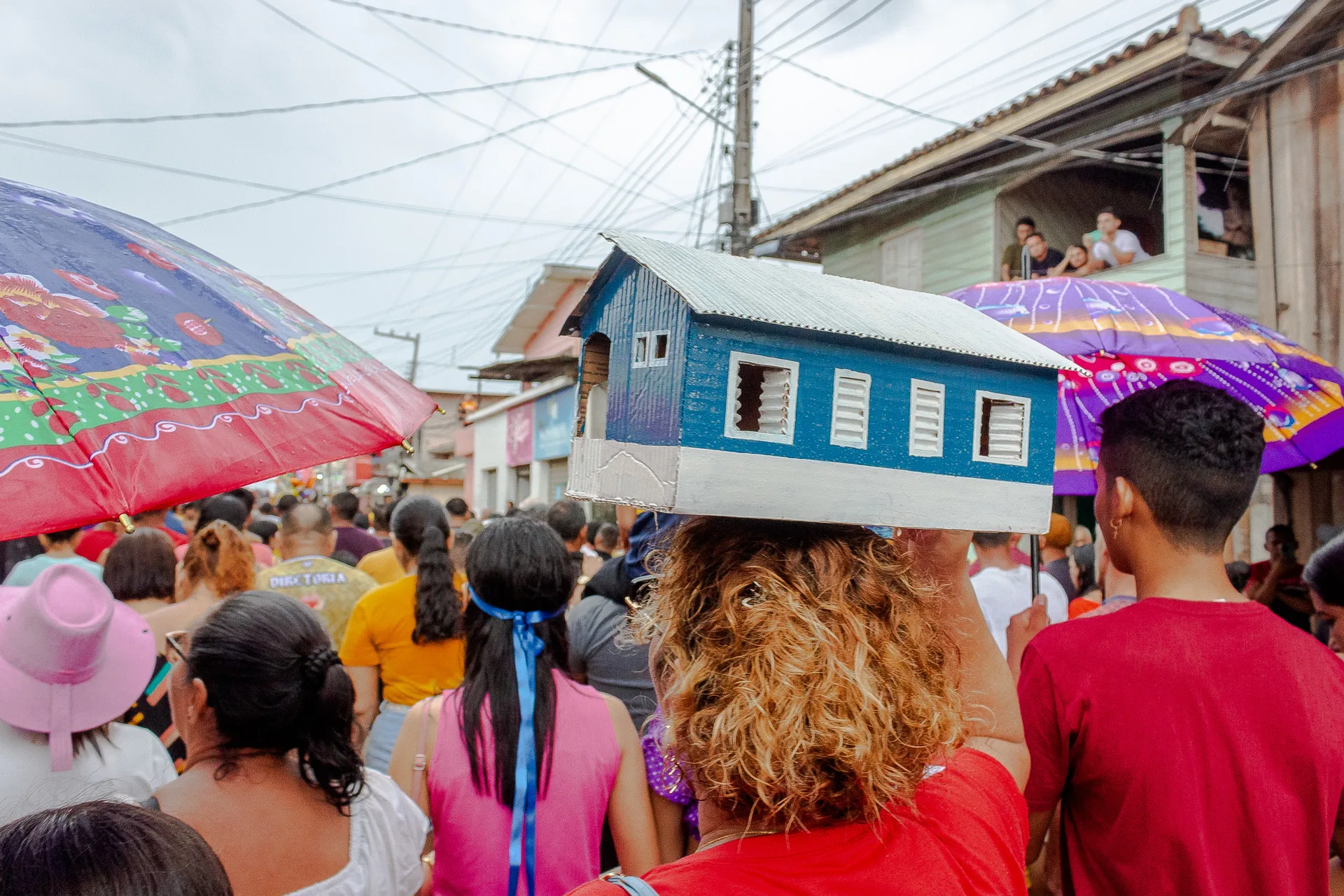
Vows answered by Saint Benedito of Gurupá are materialized through hand-crafted models
José Iram Muniz, grand master of the Jocojó Quilombo and a member of the Brotherhood for nine years, is one of the group’s 28 permanent revelers. He explains that to be a permanent reveler, you have to know all of the “old songs,” work long days, and have a gift for singing and playing instruments. The verses sung during the revelry stitch the events together as if they were an enchantment that narrates and orchestrates each action and phase of the festivities, from the very beginning, where they decorate and raise the saint’s mast on the first day, to the close, where it is knocked down. “This has come from the culture since the start, since the arrival of the Black people, the slaves here,” says José Iram.
A firm hierarchy has been established within the Brotherhood of Revelers of Saint Benedito of Gurupá. It is coordinated by two maintainers, the group’s highest authorities, followed by sergeants, flag-bearers, grand masters, drummers… Robson Wander Costa Lopes, a philosopher whose doctoral studies at the Federal University of Pará examine the social history of the Amazon, has been researching and following the revelers since 1992. He explains that these nomenclatures and symbolic degrees of command are of a military nature, “based on the Catholic tradition of these ancient brotherhoods, the revelers are a sort of royal honor guard, as if the saint were the king of that festival.”
A geography of devotions is how Robson Wander describes his perception of Gurupá’s territory since his arrival in the city on December 12, 1992, right in the middle of the festival of Saint Benedito. In his first visit to the region, he also came into contact with communities in the interior, such as Arinoá, Gurupá Mirim, Ribeira, Jocojó, and Flexinha. “I noticed many of the revelers who went to the city for the festival of Saint Benedito were from these communities, within which there were other devotions as well, like the Divine Holy Spirit, the Holy Trinity, Our Lady of Nazaré,” he says.
His studies on the territory began long before he set foot in this land, as a reader of Charles Wagley and Eduardo Galvão. These two anthropologists were in Gurupá in 1948, on an anthropological expedition, accompanied by Dalcídio Jurandir, a writer and Pará native. Robson’s scholarly curiosity about these festivities is also rooted in affection. “My paternal grandfather was a musician who played popular music that had to do with the old boi-bumbá celebrations. Through him we started to enjoy the revelry, the folklore, the popular music.” Years later, after finishing his Master’s, his dedication to this subject is what made him the Eduardo Galvão Chair at the the Historical and Geographical Institute of Pará.
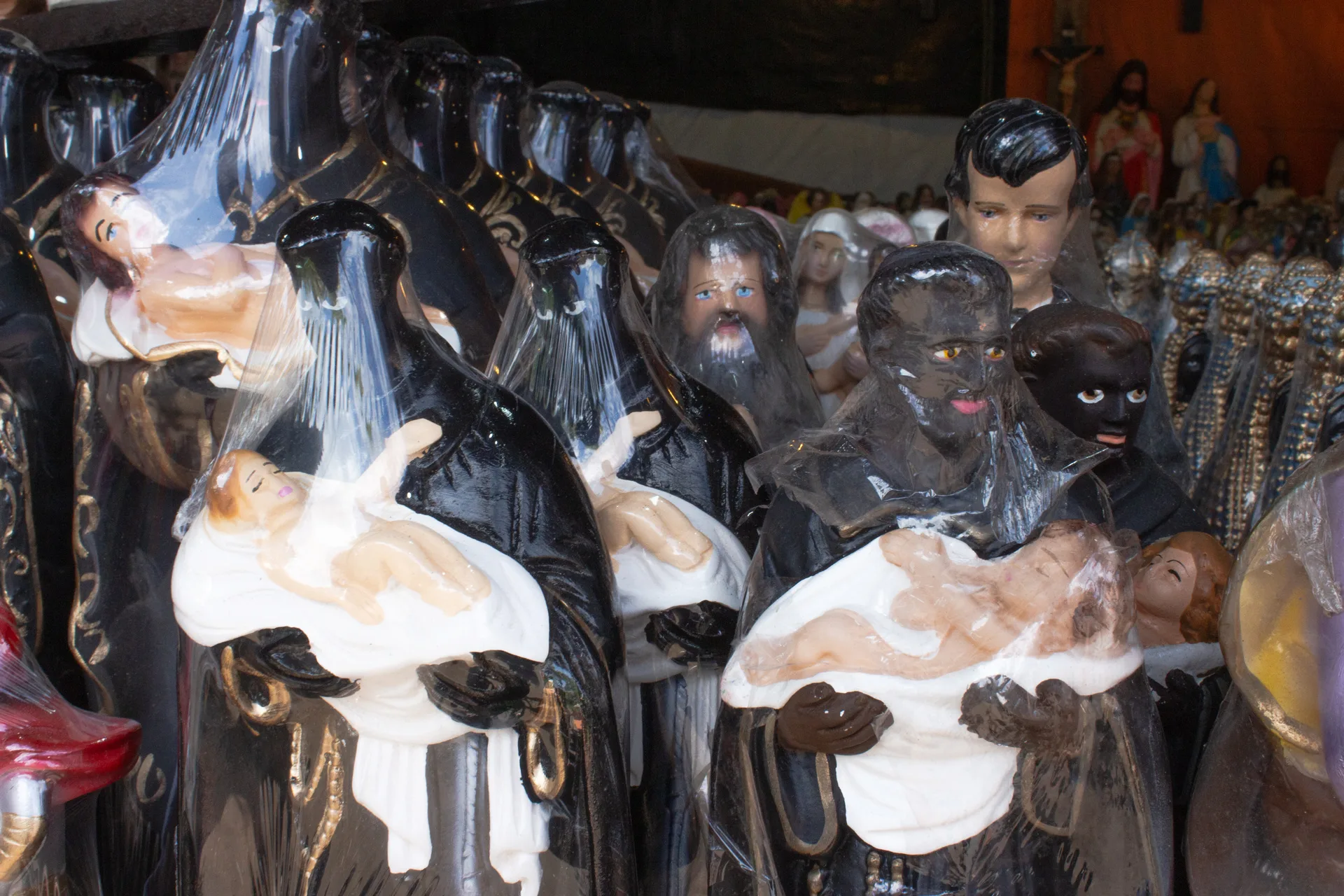
A protective Saint Benedito is shown holding the baby Jesus in his arms
There are no records of how the festival of Saint Benedito started in Gurupá. Spiritual knowledge is conveyed orally, by practicing traditions and from symbols, like the saint’s mast. It is highly valued in the celebration, representing Afro-Indigenous origins – nourished in the forest, between tidal channels and streams, on ground that was once the Indigenous territory of the Tupinambá nation, over which the Dutch, English, and Portuguese fought for every inch during colonial times. The sounds, colors, and symbols that emerge from Gurupá’s festival of Saint Benedito are elements in a movement to resist the erasures of black and Indigenous bodies and memories that found, by following the rivers, freedom from the many cycles of domination by the white man, organizing themselves into Quilombola communities around Gurupá.
By the time the image of Saint Benedito had arrived, the city’s main church already had a patron saint: Saint Antônio of Gurupá. Despite decades coexisting under the same roof, there is no rivalry. “Those two, thank God, don’t fight,” says Rosivaldo Dutra Gonçalves, 46, an educator and adviser with the Youth Ministry. The Black Saint made himself at home: as night falls, colored shadows from his lovely stained glass image are cast over the faithful sitting on the left. Atop a side altar, to the right of the central altar, Saint Benedito has watched his festival grow in popularity and dwarf the celebrations for Saint Antônio in size and importance.
The festival gathered merrymakers, drawing thousands of travelers who arrive at the port every year looking for good times, sacred and profane. At night, at the headquarters of Gurupá’s Association of Traditional Midwives, which is loaned out for Dezembrada celebrations, the older adults dance close together, enjoying the forró beats and classic brega songs and wanting to stay up all night just as much as the young people who are standing outside and having fun at parties powered by sound systems, where DJs play from lavish audio setups.
Docking in Gurupá during the Dezembrada can be a challenge; timetables shift and the arriving and departing boats are almost always filled to the brim, with hammocks rubbing up against each another. The movement has imposed a new dynamic on the city. It is a time of intense commercial activity, with sales of apparel, toys and religious items; images of São Benedito come in a wide variety of sizes. It is also normal for boats to turn into temporary hotels and for ferries to be converted into nightclubs. On Avenida São Benedito, a metal tree is topped with a shining star to keep Christmas from being completely forgotten.

Filled with devotees and visitors, the boats salute the saint with fireworks as the pass in front of the parish
Maria Valda, who lives in the city of Anajás, arrives in one of the boats saluting Saint Benedito, while fireworks explode in the sky in front of the parish. She has endured a journey of nearly 300 kilometers across the Marajó Archipelago’s waters to fulfill her vow. She had to have surgery on one eye and there were serious complications after she contracted an infection during the procedure. She lifts her sunglasses to show her left eye, half-open and lifeless. She can no longer see out of the eye, but she says the Black Saint has released her from pain and a worse fate. Wailing, she covers her eyes again and says she learned that her father passed away the night before, in Anajás. “Even though I’m very sad, I’m happy. Thank God I’ve come to fulfill my vow.”
Stories like Maria Valda’s are not forgotten in Gurupá. There is a vow room for people like her, holding old oaths, a way to bear witness and make payment for miracles achieved. There are objects, stories and messages addressed to the saint, all from devotees whose vows were fulfilled. Wax items shaped like hearts, breasts, arms and legs sit on a shelf or hang from the ceiling. “All of this represents the person’s vow, many were certainly cured because of Saint Benedito’s intercession,” says Rosivaldo Dutra Gonçalves, 46, who since 2023 has been responsible for caring for the vow room and welcoming visitors. They also leave requests, stuck to the room’s wall on colorful post-its: “My glorious Saint Benedito, I ask that you cure my mother and my aunt from diabetes and grant me grace. To learn to drive my motorcycle and get my own house.”
Many are overcome with emotion when telling their stories of devotion. Not even the sky over the city can hold back its tears. When the wandering image of Saint Benedito crossed the door into the church on the day of the procession, devotees and vow-takers were already waiting, umbrellas in hand. The rainfall on the 27th, Saint Benedito Day, is part of the tradition. Kids dressed as angels are unbothered by wet wings. Instead, they are fascinated by the bright ribbons decorating the spear and the flags. Revelers protect the saint, while the procession wends around the corners like a mythological Boiuna snake made of people and umbrellas. A woman’s voice in the crowd cries out: “The [saint] likes to bathe on his day.”
Overtaken by so many faithful, the streets shrink in size. Families standing on verandas enjoy a nice view, as if the architecture of these homes had been planned for this moment. A newborn baby is hurriedly saved from the crush by one of the revelers and is handed to a stranger outside of the crowd. At the celebrations for the Glorious Saint Benedito of Gurupá there is neither silence nor weak emotions.
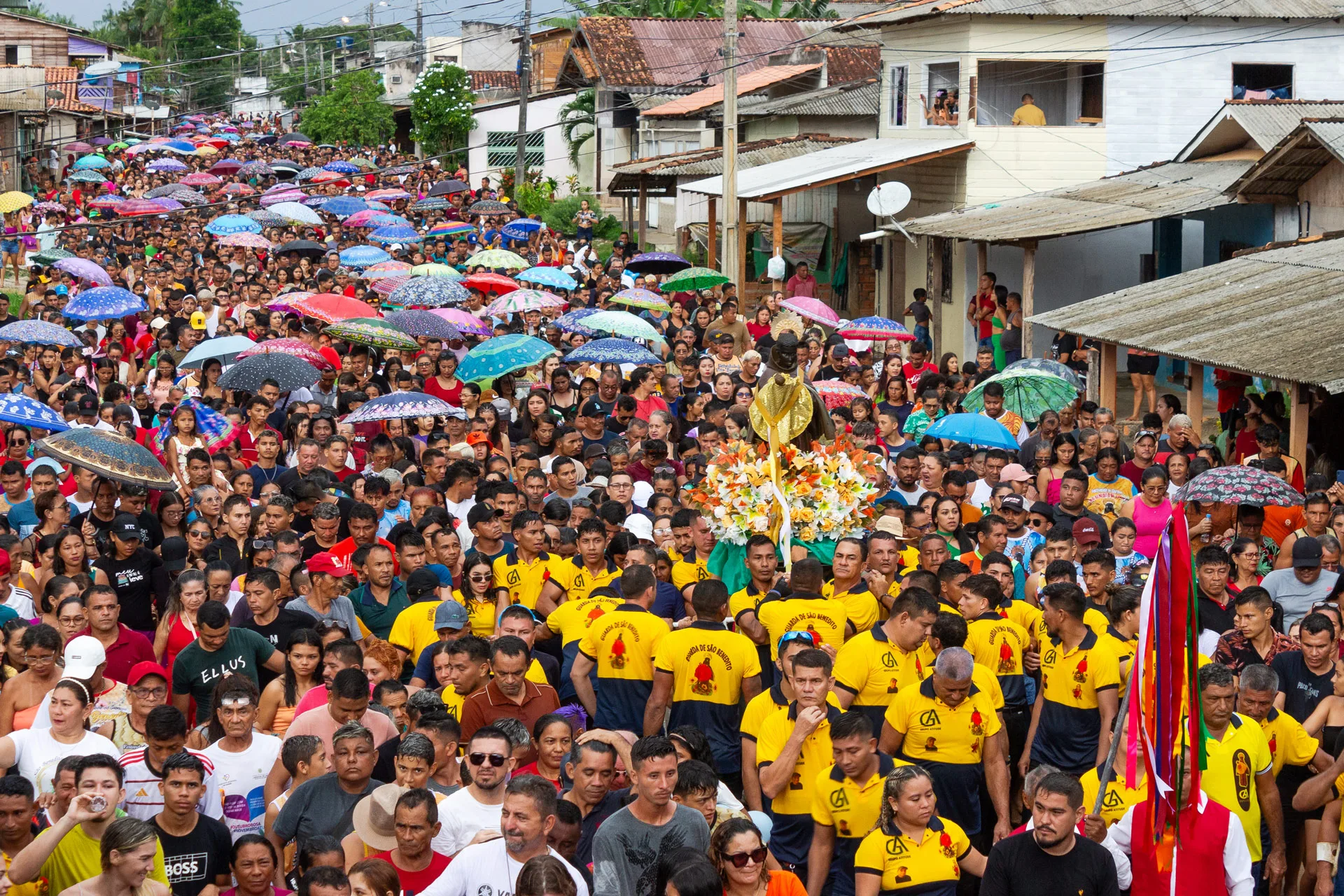
The climax of the festivities is a procession for the traveling image, on the afternoon of December 27
It all starts with the raising of the mast and ends when the mast is knocked down. The Brotherhood plays and sings Invitation to Raise and Knock Down the Mast. This is when the knocking down begins. Under the watchful eye of the mast referee, representatives from the local communities and the Brotherhood of Revelers strike the mast with an ax that is decorated with bows. In order for every representative to be able to land a symbolic blow, the referee jokingly warns them: “It’s not time to knock it down yet.” The first blow comes from the esteemed Erwin Kräutler, Bishop Emeritus of the Xingu Diocese, who has been at the festivities almost every year since 1967, with the exception of the last three, when he was sick. “I’m back! I’m so happy. When I arrived in Altamira, a beautiful reception, then in Porto de Moz, and the same here. It’s always a joy for me to be able to mete out the first blow,” he says. When the last representative returns the ax to the referee, he calls a man to finish the job, this time for real. Then the mast falls.
With the mast on the ground, according to tradition, the people draw near to remove its decorations and bark using their hands or stone tools. Those who are closest kindly hand some pieces to the others so they can keep them as a souvenir or make remedies. There is no consensus on the species of tree used, but everyone is sure of its healing powers. “They say it’s good for us to make remedies, the older ones tell us, so I got some today,” says Maria das Dores, holding a few pieces of the mast’s décor in her hands. In seconds, the devotees have stripped the mast, which sits naked.
Two flag-bearers open the way for the mast’s procession down Avenida São Benedito, spinning the saint’s massive flags in the air, followed by an orchestra of revelers. Next are the devotees, who rush to share the weight of the mast on their shoulders on the way to the “Ramada de São Benedito” – a room that houses community events, batuques, and traditional dances in the city. Its long windows do not exclude those standing outside, who can bend over the sills to watch the entertainment. That is where a few kids have perched to catch a glimpse from afar of the mast’s arrival.
It is the ritual announcing the end of the revelers’ duties, set to the sound of Varrição, a chant that opens the ways for Saint Benedito’s blessings and purifies the city’s ground. With their sleeveless red capes that symbolize a commitment to tradition, the revelers fill Gurupá’s streets in a collective gesture of faith and spiritual renewal that expresses a feeling of belonging and connection to this land. They resignify their ancestors’ pain by showing the Brotherhood’s grandeur and its capacity for organization, resistance, and to safeguard the memory that unites them. Under the grand masters’ commands, young revelers shake their milheiros and sing in unison: “That’s it, that’s it, in the church Saint Benedito sits.”
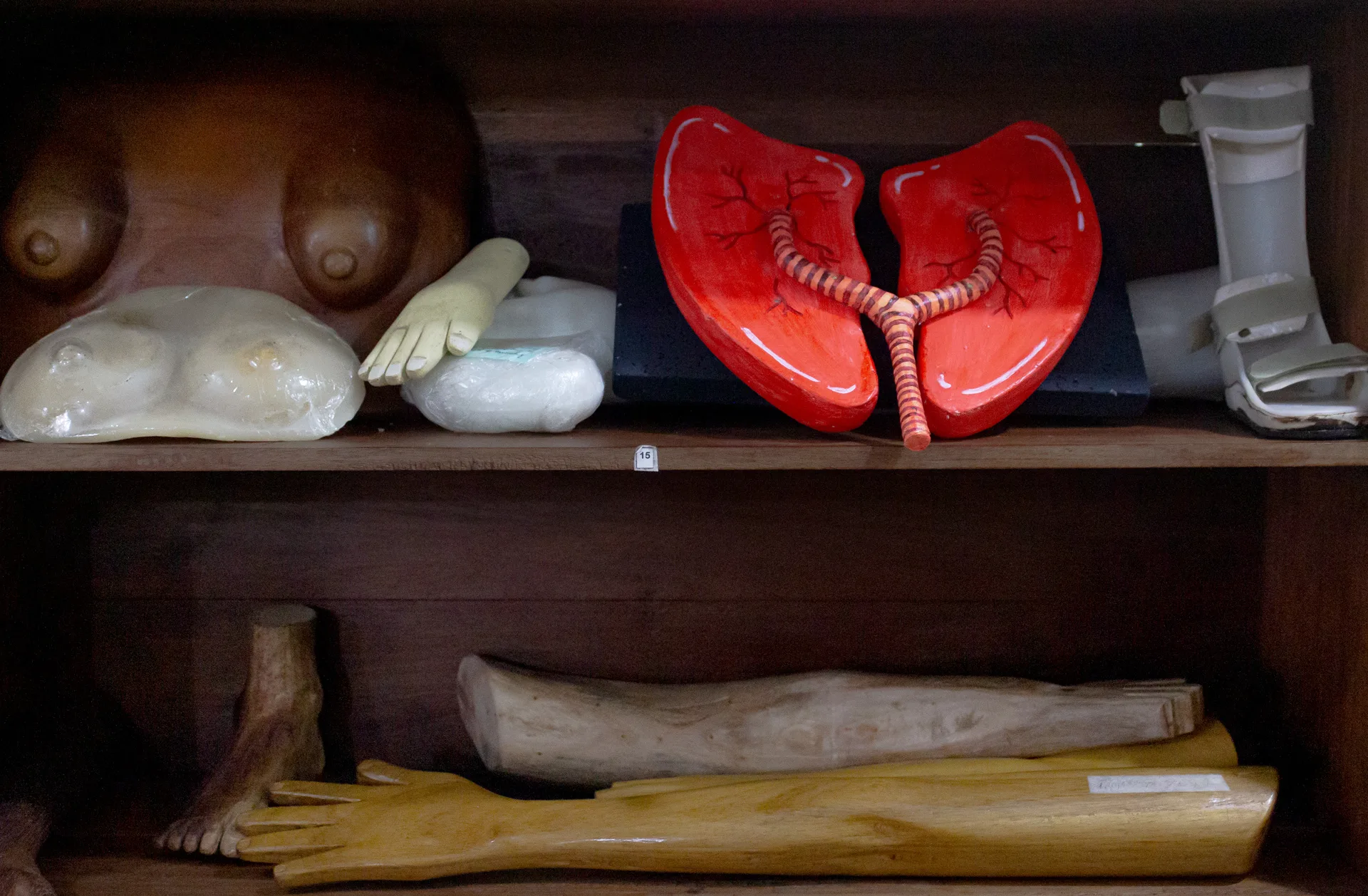
Fulfilled vows tell the story of Saint Benedict the Moor’s miraculous cures
Report and text: Soll
Editing: Eliane Brum
Photo Editor: Lela Beltrão
Fact-checker: Plínio Lopes
Proofreader (Portuguese): Valquíria Della Pozza
English translation: Sarah J. Johnson
Spanish translation: Meritxell Almarza
Copyediting and finishing: Natália Chagas
Editorial workflow coordination: Viviane Zandonadi
Editor-in-chief: Talita Bedinelli
Editorial director: Eliane Brum

